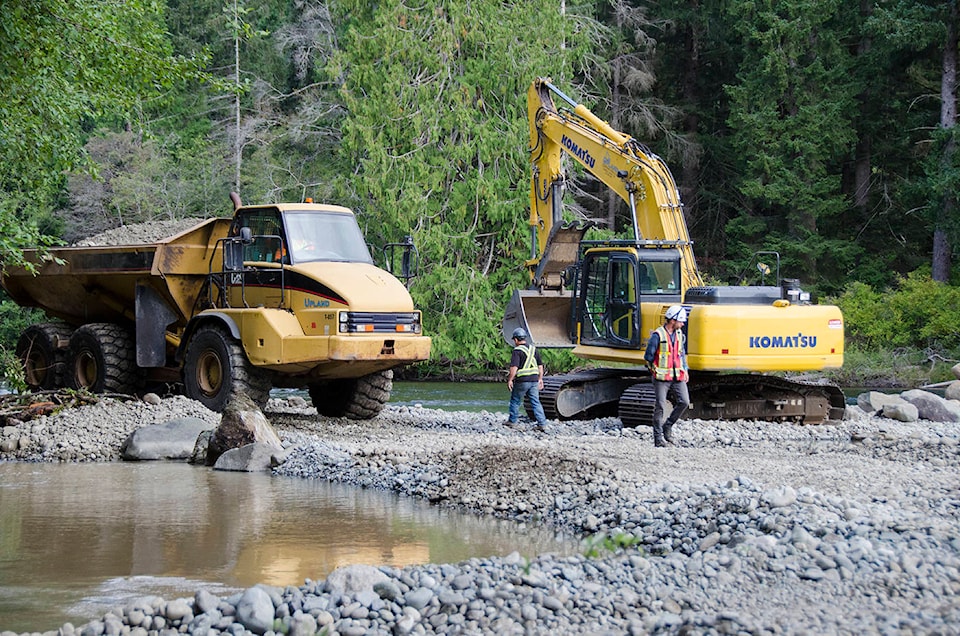The Campbell River Salmon Foundation will be leading a project to improve Chinook spawning habitats in the upper Campbell River.
The site is just upstream of the Old Elk Falls Mill Pumphouse, on the left side of the river when you are looking downstream. Spawning gravel will be placed in the mainstem river, from just opposite the top end of Second Island to about 70 metres upstream, using an excavator and off-road rock trucks.
An environmental management plan is in place, and monitoring personnel will ensure the project minimizes ecological impacts and includes a water quality sampling plan to ensure conditions are within acceptable standards, a press release from the agencies involved says.
The Canyon View Trail will remain open, however, users will be re-routed or slightly delayed as the rock trucks cross the trail to deliver gravel to the river. Security personnel will be onsite to guide everyone safely around the worksite, as well as answer any questions about the project. If there are short delays, you are asked to respect the COVID-19 protocols and maintain a two-metre distance while you wait.
Gravel will be delivered using the logging road bridge and the road into the Pumphouse so exercise caution in these areas as well.
The trail along Elk Falls #3 channel will be closed August 4-15 and work will be conducted on those days from 7 a.m. to 5 p.m.
Traffic signage will be in place to ensure the safe and efficient movement of pedestrians, trucks and local traffic.
This project is being led by the Campbell River Salmon Foundation (CRSF) with funds provided by the Fish and Wildlife Restoration Program (FWCP), an initiative to restore habitats that have been impacted by BC Hydro facilities, such as dams. Other partners providing support include the Ministry of Forest, Lands, Natural Resources and Rural Development (FLNRORD); BCParks, and Fisheries specialists, Fisheries and Oceans Canada (DFO) and BCHydro.
The project will restore up to 1,700 m2 of spawning habitat in an area historically used by Campbell River Chinook salmon and will support up to 170 pairs of returning spawners. The gravel is placed so it is barely covered by water during the low summer flows of around 30-40 metres squared per second (m2/s), but as river flows increase to 80-122 m2/s for fall spawning the water depths and velocities the Chinook prefer are provided.
Much of the lower river is lacking the gravel qualities and quantities that Campbell spawning Chinook require. Historically, gravel was washed down and deposited into the lower Campbell River from the upper watershed, providing natural gravel inputs to create spawning habitat. A series of three hydro-electric dams and reservoirs were constructed over 60 years ago and water flows over the years have resulted in gravel washed downstream and out of prime spawning areas. With no new gravel able to move from the upper watershed past the dams to the salmon spawning areas, a plan to replenish the spawning habitat through periodic additions was developed.
The Chinook spawner target on the river is 4,000 adults, based on historical escapements and habitat capacities for spawning as well as juvenile rearing of the river and estuary. The gravel placed in the mainstem Campbell River has been well used by the Chinook.
The gravel is screened and washed, at the gravel quarry, greatly reducing the potential for silt downstream during placement.
Environmental monitors will be constantly testing sediment levels in the water to ensure water quality is within acceptable standards, and have procedures in place to ensure minimal impacts. All equipment will be clean, with only environmentally friendly hydraulic fluids used.
A similar project was conducted last year in the same area of the river.
RELATED: Better gravel beds for better salmon returns on the Campbell River
@AlstrT
editor@campbellrivermirror.com
Like us on Facebook and follow us on Twitter
